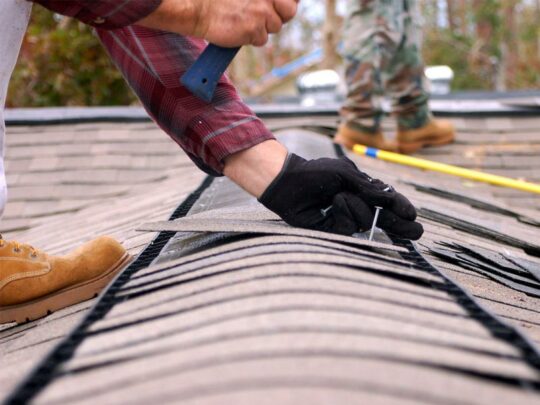You’ve noticed a water stain on your ceiling or maybe a drip. Unfortunately, these are signs that your roof may be leaking. Before professional help arrives, you can mitigate the damage and save some money with a temporary fix. Here is a simple, step-by-step guide to temporary fix a roof.
Step 1: Identifying the Problem
Your first job is to locate the leak. This can be tricky, as water doesn’t always drip straight down. It can seep along roofing panels, rafters, or insulation before soaking into your ceiling. Inspect your attic or crawl space with a flashlight, if accessible, looking for dark spots or damp areas.
Step 2: Patching Small Leaks
If the leak is minor, a sealant or roof tape may suffice. This method is ideal for small holes and cracks around flashing or joints. To apply, clean the area around the hole with a wire brush, removing any debris or loose material. Once clean, apply a generous amount of roofing sealant over the hole and smooth it out with a putty knife. For larger cracks, cover them with a patch made from a suitable material coated in sealant, ensuring it extends beyond the leak on all sides.
Step 3: Dealing with Shingle Damage
For leaks coming from damaged or missing shingles, you’ll want to replace or repair them. Slide a pry bar under the damaged shingle and gently lift until the nails holding it are visible. Remove the old shingle, slide a new one into place, and secure it with roofing nails. If you don’t have a replacement, a sheet of heavy-duty aluminum foil or metal flashing can serve as a temporary patch.
Step 4: Addressing Bigger Leaks
For larger leaks or damage that can’t be covered with sealant or a new shingle, use a tarp. Choose a tarp that is large enough to cover the damaged area and extend past it by at least 3 feet on each side. Use 2×4 boards to secure the tarp at the ridge line and eaves. Nail them down over the tarp to hold it in place.
Step 5: Consider Safety First
All these methods involve working on your roof, which can be dangerous. Always prioritize safety. Use a sturdy ladder, and wear non-slip shoes. It’s advisable to have a friend or family member with you in case of an accident.
Note:
Remember, these are temporary fixes. While they can help prevent further damage and mitigate immediate issues, they are not long-term solutions. Problems with your roof may be indicative of larger issues that can impact the structural integrity of your home. Always consult with a roofing professional to ensure the damage is properly assessed and repaired.
Finally, bear in mind that each roof is unique, and what works for one might not work for another. Consider the specific needs of your roof, including the type of materials and the extent of the damage when choosing the best approach.
By taking these steps, you can take some control over a leaking roof situation. This guide offers a way to reduce damage and costs while you wait for professional help, but it should not replace expert advice and service. Stay safe, and get your roof fully repaired as soon as you can.

